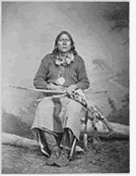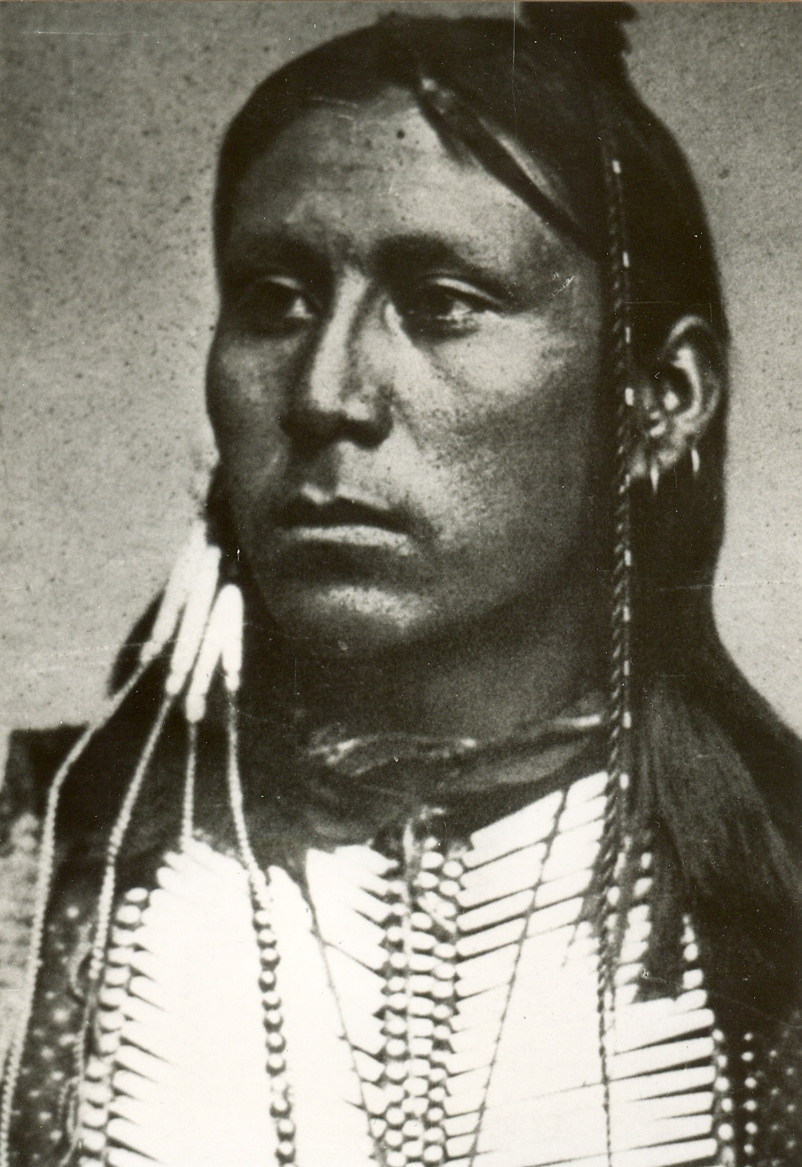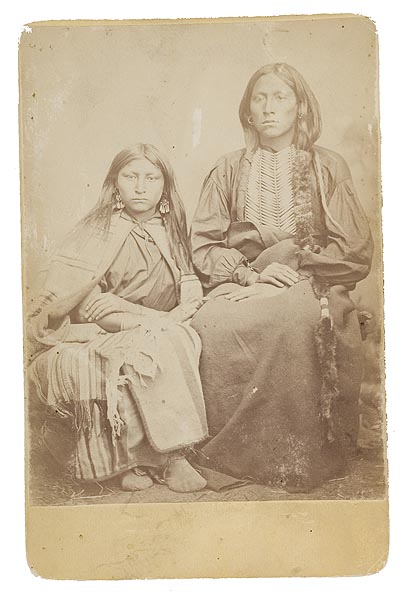|
|
Post by Diane Merkel on Jun 8, 2008 18:00:03 GMT -5
The town of Satanta [Kansas] was named after Chief Satanta, a chief and warrior of the Kiowa Indian tribe. It should be pointed out that Satanta is the white man's corruption of Set-t'ainte, the Kiowa word for White Bear.

Chief Satanta was a tall, finely formed man with a very erect bearing and a piercing glance. He was rebellious and brutal as a warrior and Chief but was eloquent in speaking and represented his tribe in many meetings with governmental officials. He could, in fact, speak five different languages fluently -- four Indian toungues and Spanish. (Newspapers reported that those who could not understand a word he said were fascinated by the rhythmic tone of his voice.) Government reports said, "his manly boldness and directness, along with a keen sense of humor, made him a favorite with army officers in spite of his known hostility to the white man's laws and civilization." He was termed, "The Orator of the Plains."
He was among the signers of the 1867 Medicine Lodge Peace Treaty. At the treaty, he spoke: "I came to say that the Kiowas and Commanches have made with you a peace. The word shall last until the whites break their contract and invite the horrors of war. [The white man] once came to trade, now he comes to fight. He once came as a citizen, now he comes as a soldier. We thank the Great Spirit that all these wrongs are now to cease and the old days of peace and friendship are to come again -- You have patiently heard our complaints. To you they have seemed trifling, to us they are everything -- For your sake, the green grass shall not be stained with the blood of the whites. Your people shall be our people, and peace shall be our mutual heritage."
Unfortunately, following that impressive speech, everyone did not live happily everafter. Soon the government withdrew many of their promises. For instance, instead of having all the land south of the Arkansas River promised them for hunting, they were soon forced to live and hunt only on a reservation near Ft. Sill, and that was one of the many agreements the government failed to fulfill. Discouraged by the white man's broken promises, Satanta's people felt they had no choice but revenge.
Because of his participation in continued raids in southwestern Kansas, southeastern Oklahoma, New Mexico, and Texas, Chief Satanta was arrested and imprisoned on three separate occasions. On October 11, 1878 while serving out a life sentence in a prison in Huntsville, Texas, he complained of an injury or that his "heart was bad" (there is some disagreement which) to the prison physician. He was taken to the prison hospital on the prison's second floor, but before treatment could be given the erie chant of the Kiowa death song was heard as Satanta plunged headfirst from the second-story balcony to the ground below, ending his long resistence to the white man's injustice to his people. From "Satanta's Passing Show" by Tom Ungles, Haskell County Monitor-Chief Thursday, May 6, 1982.
In his book Satanta: The Life and Death of a War Chief, Charles M. Robinson III said, "...it would have been in character for Satanta, in his last act as a Kiowa warrior, to deprive the whites of victory by taking his own life. They had his corpse, but not his obedience. And for a warrior, that is an honorable death."
Chief Satanta was buried unceremoniously in Huntsville in a cemetery for deceased prison inmates and those whose bodies are unclaimed. Years later, in 1963, the Kiowa Indians arranged for Satanta's remains to be moved to Fort Sill, Oklahoma. There the chief has one of the cemetery's most elaborate gravesites. Citizens of the community of Satanta arranged for a headstone. Article: www.cattlenetwork.com/Content.asp?ContentID=226030 |
|
clw
Full Member
  
Posts: 123
|
Post by clw on Jun 9, 2008 13:36:28 GMT -5
One of the great ones. I always thought the Kiowa character Blue Duck in Lonesome Dove was loosely based on Satanta.
|
|
|
|
Post by biggordie on Jun 9, 2008 16:25:49 GMT -5
And you were right. McMurtry fessed up [somewhere] but most of his readers had no idea of whom he was talking about.
Gordie
|
|
frank
Full Member
   All that is necessary for the triumph of evil is that good men do nothing.
All that is necessary for the triumph of evil is that good men do nothing.
Posts: 148
|
Post by frank on Jul 16, 2008 1:33:39 GMT -5
Ermmm... Blue Duck (one in this pic with Belle Starr) was a Cherokee right? Based loosely on Satanta the Kiowa how? Tell more details please, I've seen Lonesome Dove of course but never attached BD with Satanta.  Here is what I have on Blue Duck: Bluford "Blue" Duck ?–1895 Early Oklahoma outlaw Bluford "Blue" Duck's story, like many others, is interviewed within the legends of two other more famous western personalities; Judge Isaac Parker and outlaw queen Belle Starr. In researching the life of Blue Duck, it was difficult separating fact from fiction. Very little has been written about the man, and often what has been written is contradictory. I first became interested in this little known outlaw when I came across a reference to him while doing research on another project. Having been an admirer of author Larry McMurtry and his novel "Lonesome Dove", which as most Oklahombres members are likely to remember features a prominent Indian outlaw named Blue Duck, I became instantly curious when I came across his name. My attempts at determining whether McMurtry got the idea for his outlaw character from accounts of the real Mr. Duck proved fruitless. However, knowing McMurtry's penchant for borrowing from real life events it is entirely possible that this occurred. The first known reference to Blue Duck tells of his family living on Rogers Creek west of present day Oologah. This was during the late 1870's when Blue Duck was in his teens. Some accounts purport Blue Duck as being a white man, but most generally agree that he was Cherokee. Blue Duck's name in Cherokee was Sha–con–gah Kaw–wan–nu. In a story which has been widely written about but is largely thought to be false, Zoe Tilghman, in her 1926 work "Outlaw Days: A True History Of Early Day Oklahoma Characters", refers to Belle Starr, prior to the year 1880, interrupting a poker game in Dodge City, Kansas after her current lover lost $2000.00 in that same game. Belle is alleged to have covered the poker players with her revolver and made off with not only the amount of money in question but the entire stakes on the table. Belle's lover who lost the money in the first place was thought by some writers to have been Blue Duck. Most of the information available today indicates that this is highly unlikely to have occurred. Belle did not meet and marry Sam Starr until 1880 and it is probable that Blue Duck and Belle did not even meet until several years later. The next major event in Blue Duck's life changed it forever. On June 23, 1884, in the Flint District of the Cherokee Nation, Blue Duck and another fellow named William Christie, both drunk, rode up to where a young farmer named Samuel Wyrick was working in his field. Blue Duck emptied his revolver into Wyrick, reloaded, and then fired again at an Indian boy who was working for Wyrick. Duck then rode over to a neighboring farm and shot at but missed the neighbor. Deputy Marshal Frank Cochran arrested Blue Duck and William Christie for the murder of the Wyrick boy. The two outlaws were tried at Fort Smith in Judge Parker's court during January of 1886. Christie was acquitted and Blue Duck was convicted. Judge Parker sentenced Blue Duck to hang from the gallows on July 23, 1886, two years and one month after the crime had been committed. Blue Duck's attorney, Thomas Marcum, appealed to the President of the United States for a commutation of Blue Duck's death sentence to life in prison. While awaiting his date with the hangman, Blue Duck posed for what has become a widely publicized photograph of himself with Belle Starr. Author and historian Glenn Shirley, in "Belle Starr and Her Times", reports that Marcum hoped to call attention to his client's plight by having him photographed with Belle Starr. Marcum allegedly told Belle it would make Blue Duck feel better when he faced the noose. Shirley states that there is no proof that Belle had known Blue Duck prior to having her picture taken with him and she did not see him afterward. In "Outlaws On Horseback", Harry Sinclair Drago wrote that this photograph was taken after Blue Duck's return from prison. This is incorrect. Blue Duck's luck took a turn for the better. His death sentence was commuted and Judge Parker committed him to the Menard Penitentiary at Chester Illinois "for the term and period of his natural life". Drago writes that Blue Duck served less than one year in prison before Belle Starr was able to get him released. This is also incorrect. Archive records from the Illinois Department of Corrections indicate that Blue Duck, inmate number 2486, was admitted to Menard Penitentiary in Chester, Illinois, on October 16, 1886 serving a life sentence for murder. Blue Duck was pardoned on March 24, 1895. It is interesting to note the reason for the pardon was not given and the entry was hand written into the prison record. Blue Duck's prison record does much to dispel some of the myth about the man. It is obvious that the photograph of Blue Duck seated next to Belle Starr was not taken after his release from prison. Belle was killed in 1889, long before he was released. The prison records also make Drago's assertion that Blue Duck was murdered "by some party or parties unknown" sometime during 1887 false. In fact, Drago goes so far to say Blue Duck was probably killed by Sam Starr, jealous over Blue Duck's relationship with Belle. Sam Starr was killed in December of 1886, a few months after Blue Duck was sent to Menard. Shirley writes that Blue Duck developed consumption and was pardoned by President Cleveland on March 20, 1895. Blue Duck was given only one month to live and was released so that he could die among friends. It is generally believed that Blue Duck did indeed die shortly after his release from Menard. Blue Duck's short but violent outlaw career ended like many others. If it had not been for the photograph taken of him and Belle Starr, and the notoriety and wild speculation it caused, he more than likely would have passed through the annals of history as just another docket number in Judge Parker's court records. As luck would have it, the photograph more than likely saved him from death on the gallows and allowed him to live for almost ten more years. That same photograph also fueled a larger than life image of him being one of the many lover's of Belle Starr the Bandit Queen. This was originally taken from: www.angelfire.com/apes/westlegends/Bluford.htm but its not available there anymore... |
|
frank
Full Member
   All that is necessary for the triumph of evil is that good men do nothing.
All that is necessary for the triumph of evil is that good men do nothing.
Posts: 148
|
Post by frank on Jul 25, 2008 1:08:01 GMT -5
...and this is why there should be no posting with out registeration first...  |
|
|
|
Post by Diane Merkel on Jul 25, 2008 9:57:51 GMT -5
I deleted the post Frank was referring to in his message above. We wanted to keep the forum open, but it looks like Dietmar and I will have to re-examine that policy.
There are some seriously disturbed people in this world!
|
|
frank
Full Member
   All that is necessary for the triumph of evil is that good men do nothing.
All that is necessary for the triumph of evil is that good men do nothing.
Posts: 148
|
Post by frank on Jul 25, 2008 10:08:17 GMT -5
One solution would be that every time you want to write something you would need to write some serial number that would be shown as picture and not in writing. Thats one way to control that only humans can write in here and not spam bots.
|
|
|
|
Post by Diane Merkel on Jul 25, 2008 12:56:36 GMT -5
I know the system you mean, but I'm not sure it can be used on these boards.
We have to consider making people be registered to post. That will keep the bots out.
|
|
|
|
Post by Dietmar on Jun 23, 2009 10:55:44 GMT -5
Charlie has sent me this portrait of Satanta´s son Sa-loso:  Sa-Loso aka Wild Goose Cry, Kiowa Charlie would like to know more about Sa-loso. Thanks. |
|
|
|
Post by jeroen on Jun 24, 2009 3:53:53 GMT -5
Hey Charlie,
Had very little time to check my files, but this is what I have come up with so far:
The proper Kiowa spelling of his name is actually Tsau lau te, meaning either Gray Goose or Cry of the wild goose, he was born around 1850 to Satanta and his mother was Zone ty, Satanta's eldest wife. It is not known he was the eldest son, he probably had another brother and at least three sisters, but Tsau lau te was undoubtedly Satanta's favorite son whom he groomed to be his successor. He also was known as one of the best shots among the Kiowa. Custer said he won a contest with Tsau lau te, but the story is doubtful.
Involved in a romantic affair with the wife of another warrior, he got himself seriously wounded, but he fully recovered and when the Kiowa finally settled at the Fort Sill reservation he, like many others, became an army scout under captain Hugh Scott. He did have a daughter who passed the name Satanta down to her own son.
I also read that Tsau lau te was a member of a Kiowa war party that went out to avenge the death of a Kiowa warrior in 1879. (four years after the Kiowa settled at Fort Sill!)
When I have more, I'll post it here...
|
|
|
|
Post by charlie on Jun 24, 2009 8:08:14 GMT -5
Thank you, Jeroen. Your details are very interesting! I can added that he belonged at the band called KOGUI (Elks) such as his famous father. Looking at his face, i belive that he was a very proud warrior... I waiting for others infos.
|
|
|
|
Post by grahamew on Jun 25, 2009 14:34:20 GMT -5
 1868  Soule?  Soule?   An alternate view to the one above   With Big Tree during their incarceration  In prison  This is supposedly part of his band at Ft Sill in 1872. Is that Satanta at the right with Big Tree to his right?  Satanta at Medicine Lodge, 1867  I thought I had copied a delegation photo that Dietmar posted, but I guess not... |
|
|
|
Post by Dietmar on Jun 25, 2009 16:16:56 GMT -5
Grahame,
which one do you mean? The 1863 delegation?
Hey, the Ft. Sill photo is great. Never seen it... or at least forgot about it. Could indeed be Satanta & Big Tree, but hard to decide definetely without a better resolution scan.
Charlie, there´s more to say about Satanta´s son, I´ll have to dig out some books later...
|
|
|
|
Post by grahamew on Jun 25, 2009 16:50:52 GMT -5
I may be wrong, but he looks to be wearing the same clothes (the inconguous knitted top, similar to the one Red Dog was photographed in) that he wears in the first photo in the thread - the one I posted a larger version of and the semi-side view taken at the same time.
Pretty sure it was the 1863 delegation.
|
|
|
|
Post by Dietmar on Jul 1, 2009 3:19:24 GMT -5
Here is a photograph Charlie has sent me to post:  Daughter of Satanta & her husband, Trailing the Enemy, son-in-law of Satanta Thanks Charlie! |
|



















